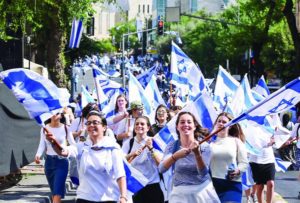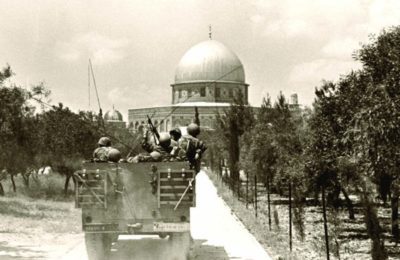
Israeli students participate in the annual flag dance from downtown Jerusalem to the Western Wall. (Kobi Richter/TPS)
JERULALEM — Thousands of Jerusalemites and Israelis from around the country capitalized on a temperate, sunny day Wednesday, May 24, to celebrate the 50th anniversary of the city’s liberation during the 1967 Six Day War.
The reunification of the city ended a 19-year period of Jordanian occupation following the War of Independence in 1948.
President Reuven Rivlin opened the official celebration on the evening of May 23 at the Western Wall, where he spoke about the difficult battle for the city in 1967, and recalled the moment he heard the Old City had been secured under Israeli control.
“We gave our all for Jerusalem because we knew that on Jerusalem we must insist,” said the President at the Western Wall.
“We will always insist on Jerusalem,” Rivlin reiterated. “There never has been, there never will be any other reality. Here, in these stones, beats the heart of the Jewish people. Jerusalem is the heart of the State of Israel, and the Kotel is the heart of Jerusalem.”
Colonel Motta Gur’s call “The Temple Mount is in our hands!” over an IDF wireless device on June 7, 1967 quickly became a defining moment for a generation of Israelis. Jerusalem Day is celebrated according to the Hebrew calendar; in 1967, June 7 was on 28 Iyar, which this year coincided with May 24.
The capture of the Old City came two days after Israel launched a preemptive strike against Egyptian forces in response to Cairo’s closure of the Straits of Tiran.
The attack ignited war with Egypt and Syria, but Prime Minister Levi Eshkol sent word to Jordan’s King Hussein that Israel would not attack the Jordanians if they did not enter the war.
However, Hussein refused and began shelling Jewish communities in western Jerusalem. Israel responded and gained control of the eastern part of the city during the fighting.
In all, Israel tripled in size during the war, gaining control of the Sinai Peninsula, the Golan Heights, the West Bank, the Gaza Strip and eastern Jerusalem.
However, since the war, Israel’s claim of sovereignty in Jerusalem and the holy sites has been the subject of international dispute.
Rivlin urged Jerusalem as a symbol of unity instead of dispute between peoples and called for “bringing peace to Jerusalem.”
“The city of Jerusalem — that was once a divided city — is the same city where Jews and Arabs, religious and secular people, find the space to live together, to meet and get to know each other; to build a shared Jerusalem, together,” he said.
Hundreds of people participated in the ceremony, including representatives of the IDF units that liberated Jerusalem in 1967, current IDF Chief of Staff Gadi Eizenkot and Mayor of Jerusalem Nir Barkat, who paid tribute to the fallen soldiers who liberated the Old City and the Western Wall. According to the Foreign Ministry, between 776 and 983 IDF soldiers were killed during the battle for Jerusalem, 4,517 people were wounded and 15 Israeli soldiers were taken prisoner.
In the Knesset, a special plenum to mark the occasion was held on Wednesday, with government officials and opposition leaders commemorating the fallen soldiers while also promoting their political agendas.
“[Israel] saved Jerusalem from neglect and distress, and we developed it successfully to become a high point in all areas,” said Prime Minister Benjamin Netanyahu. “What used to be here in Jerusalem? We must tell the truth — Jerusalem, like the entire Land of Israel, was a marginal and desolate province in the Ottoman Empire.”
He called Jerusalem an oasis of peace and interfaith within a turbulent and uncompromising Middle East, but said it faces a paradox: “The more we continue to develop the city and preserve its unique character, the more the denial and lies regarding the connection of the Jewish people to its capital intensify.
“The Western Wall is our identity card and testament to who was here and what brought us back to our homeland. We will not return to a situation where we stand overlooking while being unable to access it,” Netanyahu concluded.
Opposition leader Isaac Herzog lauded the historical and cultural accomplishments of Jerusalem but warned that the city’s demographic and geographic trends could bring about the failure of the dream the Six Day War fighters sacrificed for.
He mentioned recent statistics on Jerusalem indicating a negative migration trend, lower matriculation rates compared to the national rates, a distinct socio-economic weakness and an Arab population growth two times larger than its Jewish counterpart.
“We need to ask ourselves if the earthly Jerusalem is up to par with the Jerusalem of Gold,” stated Herzog.
“The only way to preserve a Jewish Jerusalem for a Jewish state is to materialize the vision of the two-state solution and to separate ourselves from as many Palestinians as possible,” he asserted. “Only by separating from [neighborhoods such as] Shuafat and Issawiya will we truly unify and conquer Jerusalem.”
Among the attendees at the Knesset session were Rivlin, Supreme Court President Miriam Naor and Jerusalem Mayor Nir Barkat.
In a special Army Radio broadcast in honor of Jerusalem Day, Barkat said that “Jerusalem is booming. We see it in the number and diversity of tourists, in the hi-tech sector, cultural renaissance, the tremendous investment in infrastructure for public transportation, new light rails, network cabling, among other things.
“Jerusalem is becoming more attractive, not just for tourists but also for Israeli young people and its own residents,” continued Barkat. “I am sure this process will grow and flourish as long as we continue to invest in Jerusalem.”
The Jerusalem Institute for Policy Research reported that the number of hi-tech employees in Jerusalem over the last two years has spiked by 28% (compared to a national average of 8%).
Barkat also said that Jerusalem is a successful story of coexistence, with many Arab residents living in Jewish neighborhoods, or haredi Orthodox Jerusalemites living in secular neighborhoods.
However, the 2017 Jewish People Policy Institute interim report on Jerusalem also indicates that many Jews around the world and in Israel feel that Jerusalem is not moving “in the right direction,” especially due to concerns about Jewish-Arab relations and religious pluralism.
According to Barkat, development budgets grew from half a billion shekels to three billion shekels under his leadership, but the city still faces important challenges.
The government helps Jerusalem residents in a difficult socio-economic situation by helping them with tax credits, but “unfortunately the state does not make up for the socio-economic deficits the city incurs as a consequence,” explained Barkat.
“We do have work plans to address the city’s needs for development, upgrading the infrastructure and improving the education system,” Barkat said, “but we still require more capital to move forward.”
“We all still have a lot of work to do to transform the saying ‘If I forget you Jerusalem’ into a practical reality,” said Barkat. “Fortunately, if every person connects to Jerusalem in different ways, the love for the city is present in the hearts of each and every Israeli.”
For the Ethiopian Israeli community, Jerusalem Day is also marked as a remembrance day. Ethiopian Israelis, Knesset members and Prime Minister Netanyahu held an official ceremony at Mt. Herzl on Wednesday with thanksgiving prayers and memorial services for community members who perished on the arduous journey from Ethiopia to Israel.
“We all have strong feelings about Jerusalem Day,” said Nava Asmare, a 42-year-old mother of three who was born in a small village in Ethiopia in 1975 and immigrated to Israel at the age of 10.
“On one hand, there is an intense feeling of gratitude and humility that we made it to Jerusalem and to the Land of Israel.
“On the other hand, it is the day we remember all the people who dreamed about Jerusalem but never made it here.”
Asmare’s 10-month old sister died in her mother’s arms during the journey.
When Ethiopian Jews began immigrating to Israel during the 1980s and 90s, the journey was often treacherous, marked by thousand-mile walks through hostile territory, hunger, sickness and wild animals. Veterans of the move remember people “dropping and dying like flies” in transit camps, waiting to be airlifted to Israel in 1984 during Operation Moses and during Operation Solomon in 1991.
According to Asmare, the lofty, mythical ideas of Jerusalem that many Ethiopian Jews grew up with led to a strong sense of a disconnection when they finally arrived in the Holy City.
“I absolutely believed that Jerusalem would be this magical place, a real Jerusalem of gold,” she said. “We all did. We thought we would get to Jerusalem and be blinded by the gold and the light and the sanctity.”
“Of course, that’s not Jerusalem today. We celebrate the unification of Jerusalem today, but we also know that in some ways the city is broken, not unified. There’s the upper, heavenly Jerusalem and the earthly Jerusalem. The Jerusalem of our dreams versus the actual city. So there are many, many mixed emotions,” Asmare added.
















